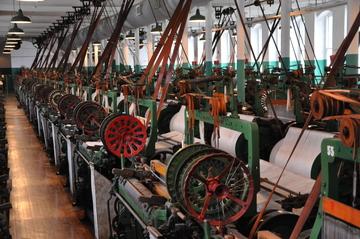To solve the Mystery Spot 44 puzzle you had to figure out which named place in which of America’s 397 national parks can be identified by interpreting the following clues:
a noisy interlace place
a globetrotting Thomas
a covering for part of the leg
a coffee grinder
a warship that famously fought to a draw
The answer is the Weave Room in the Boott Cotton Mills Museum at Lowell National Historical Park in downtown Lowell, Massachusetts.
Lowell National Historical Park tells the story of the farm-to-factory transition, immigrant and labor history, and the emergence of America’s industrial technology. Lowell is a logical place to commemorate the history of America’s Industrial Revolution, since southern New England was America’s first major manufacturing region and the city of Lowell is considered by many to be America’s first great industrial city.
Lowell’s location on the fall line of the Merrimack River made it relatively easy to harness waterpower for industrial use. Mills and a canal system were constructed in the 1820s, and textile manufacturing began in earnest. By the mid-1800s, Lowell had ten major textile mill complexes that employed more than 10,000 workers and produced about 50,000 miles of cotton cloth a year.
The Boott Cotton Mills Museum is the park’s interpretive centerpiece. While the museum has interactive exhibits and video programs about the Industrial Revolution, labor history, and Lowell’s rise, fall, and rebirth, its feature attraction is a 1920s-era weave room with 88 Draper “Model E” looms operated by trained volunteers. Seeing the looms in action and listening to the roar of the machinery is a never-to-be-forgotten experience.
Here is how the clues lead you to the answer:
A boot is a covering for part of the leg.
A coffee grinder, like other grinders, is also known as a mill.
To weave is to interlace. A weave room is consequently “an interlace place”.
Lowell Thomas (1892-1981), the man for whom the Explorers Club’s Lowell Thomas Award is named, was one of America’s most famous journalists. Lauded for his many accomplishments as a writer, editor, broadcaster, photographer, businessman, narrator, etc., etc., he was renowned as a globetrotting traveler/explorer/adventurer.
In one of the most important battles in American naval history, the Union ironclad USS Monitor fought the Confederate ironclad CSS Virginia to a draw in the March 1862 Battle of Hampton Roads. The CSS Virginia, whose construction incorporated the lower hull and steam engines of the scuttled USS Merrimack, is almost invariably (albeit inaccurately) referred to as the Merrimack, as in “Battle of the Monitor and Merrimack.”
Congratulations to the Traveler readers who figured this one out: Eric, jchappell740, Ken, Moonpie, celbert, RoadRanger, Ranger Dave, RangerLady, Anon 9:56, and s. All have qualified for our monthly prize drawing and a chance to win a copy of David and Kay Scott's The Complete Guide To The National Park Lodges, 7th Edition.




Add comment